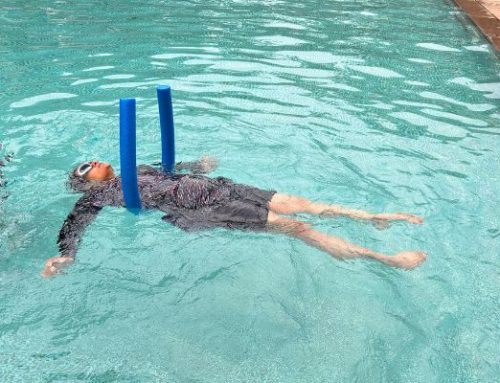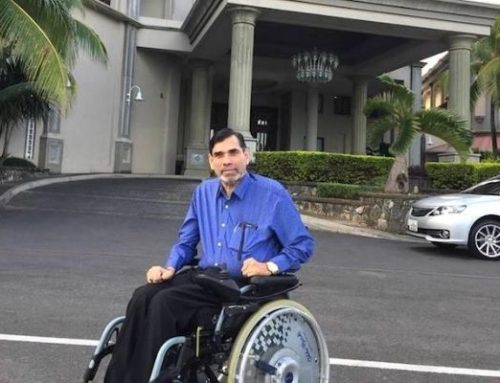“Demystifying spinal cord injury”
Let’s face it unless you have one or are involved in the treatment of someone with it; there is very little chance that you are aware of spinal cord injuries. We all have heard about life-threatening accidents and diseases such as cancer, HIV/AIDS, and the most recent Coronavirus. Thankfully enough has been written about them, which has increased awareness and sensitivity on the topic.
A Spinal cord injury (SCI), on the other hand, may seem like a black box too many. You can see that the injured person is not able to move hands or legs voluntarily. ‘Paralysed‘ is an easier way of looking at it (extremely useful at airport security checks, where you have to explain the condition quickly) since it is a commonly used term. However, there is a lot under the hood.

Pic credit: Gabriele – CC
What is a spinal cord injury?
I’ll tell you how I’ve come to understand it.
The spinal cord is home to a lot of nerves. These nerves carry signals from the brain to different parts of the body and organs so that they can carry out the desired function. For example, moving your toe up and down or peeing when you want to. The nerves also communicate sensations from the body to the brain, such as burning if you put your finger in hot water or pain if you get a cut on your ankle. There are millions of nerves connecting the brain with different parts of the body and muscles.
After an SCI, the nerves get fractured. A fracture means that the brain is no longer able to communicate through the nerves. No communication => paralysis below the level of injury; neck, upper back or lower back.
Now, if one gets a fracture on the forearm, it can be usually put together with a few plates, screws and a cast that will keep it in the same position – allowing the bone to regenerate and ultimately join. Further, it will help if you visualise a million nerves neatly tucked inside your spinal cord (yes, that backbone which runs from behind your neck till your lower back). Even once the nerves regenerate, there is no guarantee that each one of those will connect with their corresponding counterparts. It is difficult for doctors to predict complete recovery.
This animated video is also pretty cool when it comes to simplifying and explaining SCI. For more detailed reading there’s always Wikipedia and a host of online resources.
The real deal
Getting a spinal cord injury is just the beginning. The real deal starts after that.
No control over parts of the body below the injury – for me, it’s everything below the shoulders – this makes moving around and doing things by oneself challenging, even turning over from one side of the bed to another.
Not being able to use hands and fingers – this is probably the most annoying. Just notice how many times and for all the different kind of activities that you use your hand and fingers throughout the day – and then imagine not being able to use your hands.
No control over bowel and bladder – one has to learn to manage them over a period of time.
Spasticity/ tightness of muscles resulting from less movement of hands and legs – comes in the way of body movement; e.x. If I sit for an extended period or if the temperature is cold, my legs get spastic – the muscles tighten, legs try to become straight, and I have to keep them from leaving the foot-rest else my chances of slipping from the wheelchair increases.
Situations that can develop into serious problems if one doesn’t take enough care: pressure sores (no sitting or lying down in the same position for a very long time), urinary tract infections (maintaining hygiene, drinking enough water and healthy citrusy drinks), low blood pressure, difficulty in breathing for some and many more.
The objective of listing all these is not to make the world of SCI sound gloomy. Consider this as a sneak peek that will help you see the other side. Also, not everyone faces each one of these situations. Some of it depends on the level of injury, but most of it depends on being aware and taking precautions.

Before and after spinal cord injury
There’s still a lot under the hood. I haven’t even touched upon matters of the mind. Accepting the injury, sad at not being able to do things by oneself, the guilt of being a burden on your loved ones, low self-esteem and confidence, irritation when so many things around us are not accessible, end of privacy, the need for someone to watch over all the time and so on.
It’s not easy to deal with all of the above. Being aware is the first step, and the rest follows.
I’m fortunate to have many wise people who have found their way into my life, friends and family that remind me of “this too shall pass”, “things will get easier eventually”, “we are in this with you” and “it’s all in the mind”. If I had to pick the most important experience and take away that would be “things may seem impossible, but you can make them possible – and the trick is straightforward, just keep trying”. The energy-enthused physiotherapists and the support system at rehab centres such as the Indian Spinal Injuries Centre worked like magic for me. Not sure how long it would have taken for me to visualise the world of possibilities otherwise.






Mrunmaiy, i have always said this and continue… You are a true fighter and inspiration.. You played a major role in me fighting my illness.
Do keep updating this blog and messaging me… I would like to read regularly.
Do write about the challenges you had to face, how you made and making adversities your strength.
I salute you and your family… Strength and Love Personified.
truly inspirational hats off to you gal ! so proud of you ! you are so brave and a true fighter much love and hugs!
I understand this is not simple… But just know that you are tougher than the situation and will get through Mrun!! Love n best wishes!! Nidhi Jain Sarda
Hi Mrunmaiy! I had met you at a Nagpur tweetup in maybe 2010. Shocked to hear about everything that has changed for you ever since, but I’m simply amazed by your strength. Thank you also for this very informative writeup! Many hugs to you.
Hey Tejaswinee. Loooooong time. Hope you’re doing great 🙂
[…] my costume – just in case I get time for a quick dip. Things obviously changed after my cervical spinal-cord injury. Forget swimming, I was not even able to move around the house by myself. I lived life confined to […]
[…] am a quadriplegic, paralyzed below my shoulders due to a spinal-cord injury. Using a wheelchair has only changed the […]
[…] Also read: Demystifying spinal cord injury […]
[…] Also read: Demystifying spinal cord injury […]
[…] When we grow up, the tables turn. Now it is our time to take care of her. But then some of us get a spinal cord injury and return back to the kid-mode. This video of mothers and their kids with disabilities has left me […]
[…] You can read about the finer details of living with quadriplegia in my previous blog. […]
[…] You can understand more about my cervical spinal-cord injury by reading here. […]
[…] A lot of times I wonder how life would have been without all the tech around us. In my case – it’s assistive-technology. Paralysed below the shoulders with no finger movement in the hands, I am extremely thankful for all the tech and gadgets which help me out in life. They don’t just make me more independent but also helped me in regaining confidence after my introduction to quadriplegia. […]
Great post. I have a spinal injury myself. But mine is an incomplete injury, so I’m not paralysed. What is care like for spinally injured people in India? I live in the UK, so I’m interested to hear about the experiences of people with SCI in other countries.
Hey Alex,
Just realised I missed responding on this one.
It is tough living with a SCI in India. No insurance covers hospitalisation for rehabilitation, physical therapy and the life long expenses we have for assistive aids like wheelchair and medicines. There are only a handful (3-4 nos.) rehabilitation centres, across the country of over 1.2 billion population, that know what they’re doing. Almost every other SCI I know has a tough story about his experience with agencies and the untrained nursing care. My estimate is that less than 5% of the entire country is accessible, which means we cannot step out of our homes on a wheelchair that easily. Of the hundreds of cities, only five or six have accessible transport taxis. It’s tough for people with SCI to get skilled and find jobs.
However, many of us manage to get on with lives because of supportive family, sustainable jobs and the biggest factor ‘PEER SUPPORT’. The ones who have Internet/WhatsApp benefit from the peer support, but there are many who are not able to get online & struggle to even find out about the world of possibilities after a injury. While the government is not doing enough, thankfully there are organisations led by fellow SCIs that reach out to the hinterlands, remote villages and cities, provide financial aid, facilitate rehabilitative treatment, and are always available for counselling.
It’s hard for me to imagine not being able to get out the house very easily and travel around the country. It’s a good job there are the organisations that support people with SCIs. I hope that in the near future the government do more to improve access for disabled people around the country.
Thanks for sharing.
[…] To know more about what a spinal cord injury is, head over to my evergreen post: Demystifying spinal cord injury. […]
[…] This is the second article in a series where I discuss how my life has changed after a spinal cord injury. The first one talks about the change from being independent to becoming dependent. To understand what a spinal cord injury is you can read Demystifying spinal cord injury. […]